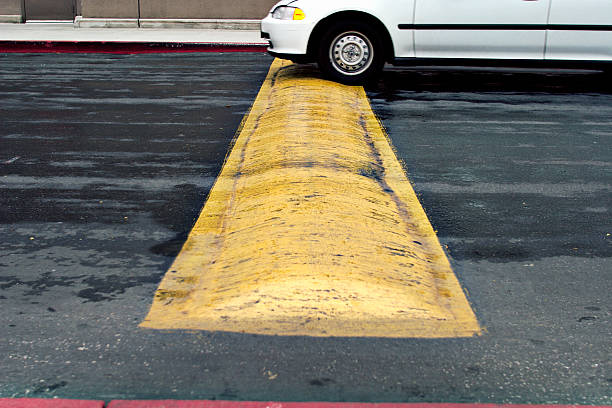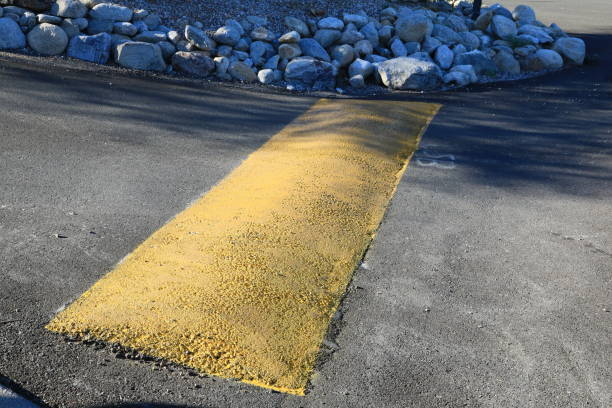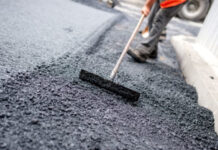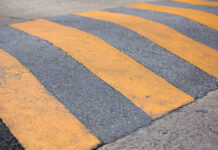How to Maintain and Repair Speed Bumps for Asphalt: Essential Tips for Longevity
Speed bumps play a crucial role in traffic management, especially in areas where reducing vehicle speed is essential for safety. When installed correctly on asphalt surfaces, they help prevent accidents, protect pedestrians, and ensure smooth traffic flow. However, to maximize their effectiveness and longevity, proper maintenance and repair are essential. In this comprehensive guide, we’ll cover everything you need to know about maintaining and repairing speed bumps for asphalt, ensuring they remain functional and durable for years to come.
For expert advice or professional services regarding speed bumps for asphalt, contact Commonwealth Paving at +1 502 459 7283 or visit us at 136 Outerloop, Louisville, Kentucky 40214. Our team of specialists is here to assist with all your paving needs.
Understanding Speed Bumps and Their Importance
Speed bumps for asphalt are traffic calming devices designed to reduce vehicle speed in specific areas. They are typically installed in parking lots, residential streets, and other areas where controlling speed is necessary for safety. Made from various materials such as asphalt, rubber, or plastic, speed bumps work by creating a physical obstacle that forces drivers to slow down.
Benefits of Speed Bumps
- Enhanced Safety: By reducing vehicle speed, speed bumps help prevent accidents and improve pedestrian safety.
- Traffic Flow Management: They regulate traffic flow in areas where speed control is critical, such as near schools or in parking lots.
- Reduced Noise: Properly designed and maintained speed bumps can help minimize noise generated by speeding vehicles.
Regular Maintenance of Speed Bumps
Maintaining speed bumps for asphalt ensures their effectiveness and extends their lifespan. Here are key maintenance tips to keep in mind:
1. Routine Inspections
Regular inspections are crucial for identifying potential issues before they become major problems. Conduct visual inspections of the speed bumps to check for signs of wear, damage, or displacement. Look for:
- Cracks: Inspect for any cracks or fractures in the speed bump surface.
- Displacement: Ensure that the speed bump is properly aligned and has not shifted or become uneven.
- Surface Wear: Check for signs of erosion or wear on the bump’s surface.
2. Cleaning
Keeping speed bumps clean helps maintain their visibility and effectiveness. Regularly remove debris, dirt, and vegetation from the speed bumps to prevent obstruction and ensure they are easily visible to drivers.
3. Painting and Marking
Repainting and remarking speed bumps periodically improves their visibility, especially during low-light conditions. Use high-quality, durable paint designed for asphalt surfaces to maintain clear and visible markings. Ensure that the markings are refreshed as needed to retain their effectiveness.
4. Addressing Cracks and Damage
Addressing cracks and damage promptly helps prevent further deterioration. Here’s how to handle common issues:
- Cracks: For minor cracks, use an asphalt crack filler to seal them and prevent water infiltration. Clean the crack thoroughly before applying the filler.
- Surface Damage: For more significant surface damage, such as potholes or large cracks, consider resurfacing or patching the affected area to restore the speed bump’s functionality.

Repairing Speed Bumps on Asphalt
Repairing speed bumps for asphalt involves fixing any damage and ensuring the bump is properly aligned and functional. Follow these steps for effective repair:
1. Assessing the Damage
Before starting repairs, assess the extent of the damage to determine the appropriate repair method. Common issues include:
- Cracks and Holes: These can compromise the bump’s effectiveness and need to be repaired.
- Displacement: If the speed bump has shifted or become uneven, realignment may be necessary.
2. Preparing the Area
Prepare the damaged area for repair by following these steps:
- Clean the Area: Remove any debris, dirt, and loose material from the damaged area to ensure proper adhesion of repair materials.
- Remove Damaged Sections: For significant damage, such as large cracks or holes, remove the damaged sections of the speed bump.
3. Repairing Cracks and Holes
- Crack Filling: Use an asphalt crack filler for small to medium cracks. Apply the filler according to the manufacturer’s instructions and smooth it out with a trowel.
- Patching: For larger holes or damaged areas, use an asphalt patching compound. Apply the compound in layers, compacting each layer before adding the next. Smooth the surface to match the surrounding area.
4. Resurfacing
If the speed bump is extensively damaged or worn, resurfacing may be necessary. Here’s how to resurface a speed bump:
- Clean and Prep: Remove all loose material and clean the surface thoroughly.
- Apply Resurfacing Material: Use a high-quality asphalt resurfacing material to cover the entire speed bump. Spread the material evenly and compact it using a roller or compactor.
- Allow Curing: Let the resurfacing material cure according to the manufacturer’s recommendations before using the speed bump.
5. Repainting and Marking
After repairing and resurfacing, repaint the speed bump with high-visibility paint and remark any necessary lines or symbols. Ensure the paint is suitable for use on asphalt and provides good visibility in various lighting conditions.
Preventive Measures for Longevity
Taking preventive measures helps extend the lifespan of speed bumps for asphalt and reduces the need for frequent repairs. Consider the following tips:
1. Proper Installation
Ensure that speed bumps are installed correctly from the start to minimize wear and damage. Follow recommended installation guidelines and use high-quality materials designed for asphalt surfaces.
2. Regular Maintenance
Implement a regular maintenance schedule to address minor issues before they escalate. Routine inspections, cleaning, and minor repairs can significantly extend the life of speed bumps.
3. Avoiding Heavy Traffic
If possible, limit the use of speed bumps in areas with heavy or frequent traffic, as excessive vehicle weight and repeated impacts can accelerate wear and damage.
4. Using Durable Materials
Choose durable materials for speed bump installation and repairs. High-quality asphalt, rubber, or plastic materials designed for heavy use will last longer and require less frequent maintenance.
Maintaining and repairing speed bumps for asphalt is essential for ensuring their effectiveness and longevity. Regular inspections, cleaning, and timely repairs help keep speed bumps functional and safe, enhancing traffic management and protecting pedestrians and property.
If you require professional assistance with speed bumps for asphalt, contact Commonwealth Paving at +1 502 459 7283 or visit us at 136 Outerloop, Louisville, Kentucky 40214. Our team of experts is dedicated to providing top-quality maintenance and repair services, ensuring your speed bumps remain in optimal condition.
By following these essential tips and practices, you can ensure that your speed bumps continue to serve their purpose effectively, contributing to a safer and more organized parking environment.
Understanding Different Types of Speed Bumps for Asphalt: Which is Best for Your Needs?
When it comes to managing traffic flow and safety in various environments, speed bumps for asphalt play a crucial role. Whether you’re maintaining a parking lot, a residential street, or a commercial driveway, choosing the right type of speed bump is essential for ensuring both safety and comfort for drivers and pedestrians. However, not all speed bumps are created equal. Depending on the specific needs of your project, there are different types and designs to consider.
In this comprehensive guide, we’ll walk you through the various types of speed bumps for asphalt, their specific uses, benefits, and drawbacks, and how to determine which one is the best fit for your needs. By the end, you’ll be well-informed to make the right decision for your paving project, whether it’s at a school, shopping mall, or industrial complex. For expert assistance, Commonwealth Paving, based at 136 Outerloop, Louisville, Kentucky 40214, is always here to help. Contact us today at +1 502 459 7283 for personalized advice.
Why Are Speed Bumps Important?
Before diving into the types of speed bumps for asphalt, it’s important to understand why they are necessary. Speed bumps are traffic-calming devices that slow down vehicles in areas where excessive speed can be hazardous. These devices are commonly installed in:
- Parking lots
- Residential streets
- School zones
- Shopping centers
- Industrial complexes
Without proper traffic control, vehicles may speed through these areas, creating a dangerous environment for pedestrians and other drivers. Speed bumps not only reduce vehicle speeds but also help control traffic flow and improve safety.
However, selecting the right speed bumps for asphalt requires consideration of a variety of factors, including the location, type of traffic, and speed limits. Let’s explore the most common types available for asphalt surfaces.
1. Traditional Speed Bumps
Overview:
Traditional speed bumps are the most commonly recognized type and are typically installed in low-speed areas like parking lots and private roads. They are raised strips that force vehicles to slow down significantly—usually to around 2 to 10 miles per hour (mph).
Key Features:
- Height: 3 to 6 inches
- Width: Typically 12 to 14 inches
- Material: Often made from asphalt, rubber, or concrete
Best For:
- Parking lots
- Private roads
- Low-traffic residential areas
Benefits:
- They are highly effective at reducing vehicle speeds, especially in areas with high pedestrian activity.
- Their relatively low cost makes them a budget-friendly option for traffic management.
Drawbacks:
- Traditional speed bumps can cause discomfort for drivers, especially at higher speeds.
- They are not suitable for high-traffic or emergency vehicle routes, as they can cause delays.
Speed bumps for asphalt in this category are ideal for those looking for maximum traffic control in areas with moderate to low vehicle flow. Commonwealth Paving offers installation services for this type, and we can help you determine if this is the right fit for your project.
2. Speed Humps
Overview:
Speed humps are similar to speed bumps but differ in terms of shape and purpose. While speed bumps are shorter and more abrupt, speed humps are wider and cover more surface area, which allows vehicles to pass over them at slightly higher speeds—usually around 10 to 15 mph.
Key Features:
- Height: 3 to 4 inches
- Width: 10 to 14 feet
- Material: Asphalt, rubber, or concrete
Best For:
- Residential streets
- School zones
- Low-speed roads with higher vehicle flow
Benefits:
- Speed humps are less jarring than traditional speed bumps, making them more comfortable for drivers.
- They effectively reduce speeds while maintaining smoother traffic flow.
Drawbacks:
- While they slow down vehicles, they might not reduce speeds enough for areas with very high pedestrian traffic.
- Their larger size can make installation more complex.
Speed humps are a great option if you need to manage speed without significantly disrupting traffic flow. They are commonly used in residential areas where safety is a concern, but higher vehicle speeds are still acceptable. Commonwealth Paving can help you install these speed bumps for asphalt in Louisville and surrounding areas.
3. Speed Cushions
Overview:
Speed cushions are a modified form of speed humps, designed specifically to accommodate emergency vehicles and buses while slowing down regular traffic. They consist of a series of raised sections that allow larger vehicles to pass through without having to slow down as much.
Key Features:
- Height: 3 to 4 inches
- Width: 6 to 7 feet per section
- Material: Asphalt, rubber, or concrete
Best For:
- Emergency vehicle routes
- Bus lanes
- Streets where both large and small vehicles frequently travel
Benefits:
- Speed cushions are versatile and can be customized to allow for smooth passage of specific vehicles.
- They reduce speeds for most vehicles without impeding emergency response times.
Drawbacks:
- Not as effective at reducing speeds for smaller vehicles as traditional speed bumps or humps.
- More expensive to install and maintain due to the segmented design.
For areas that require a balance between speed control and emergency access, speed cushions are an excellent choice. Commonwealth Paving specializes in custom speed bumps for asphalt, including speed cushions that can be tailored to your traffic needs.
4. Speed Tables
Overview:
Speed tables are flat-topped speed humps that offer a more gradual rise and fall than traditional speed bumps. They are commonly used in areas with higher speed limits and more frequent traffic, allowing vehicles to maintain speeds of 20 to 25 mph while still slowing down enough to ensure safety.
Key Features:
- Height: 3 to 4 inches
- Width: 22 feet or more
- Material: Asphalt, concrete, or rubber
Best For:
- Streets with moderate traffic
- School zones
- Pedestrian crossings
Benefits:
- Speed tables provide a smoother ride for drivers compared to bumps and humps.
- They are ideal for areas where both safety and traffic flow are important, such as busy intersections or crosswalks.

Drawbacks:
- They are more expensive than traditional speed bumps and humps.
- Speed tables are less effective at slowing down vehicles in areas where very low speeds are required.
Speed tables are often the go-to choice for municipalities looking to balance safety with traffic flow in moderate-speed areas. Commonwealth Paving offers installation and maintenance services for these speed bumps for asphalt, ensuring long-term durability.
5. Bolt-Down Speed Bumps
Overview:
Bolt-down speed bumps are portable, modular traffic-calming devices made of rubber or plastic that can be installed temporarily or permanently. They are typically bolted down to the asphalt surface and can be easily removed if needed.
Key Features:
- Height: 2 to 3 inches
- Width: Varies depending on design
- Material: Rubber or plastic
Best For:
- Temporary traffic control
- Construction zones
- Events and special occasions
Benefits:
- These speed bumps are easy to install and remove, making them ideal for temporary traffic management.
- They can be reused, offering cost savings in the long run.
Drawbacks:
- Rubber or plastic models may not be as durable as asphalt or concrete.
- They may not offer the same level of speed control as permanent installations.
If you’re looking for a temporary solution, bolt-down speed bumps for asphalt are a cost-effective option. Commonwealth Paving can provide and install these as needed, ensuring quick setup and removal.
Factors to Consider When Choosing Speed Bumps for Asphalt
Choosing the right speed bumps for asphalt involves several key factors, including:
- Location: Where will the speed bumps be installed? Parking lots, residential streets, and emergency vehicle routes each require different designs.
- Traffic Volume: How many vehicles are expected to travel through the area? Higher traffic volumes may require speed humps or tables to ensure smoother flow.
- Speed Limit: What is the desired speed for vehicles in the area? Traditional speed bumps are best for very low-speed areas, while speed tables or humps are better for higher-speed zones.
- Pedestrian Activity: Areas with a lot of pedestrian traffic may benefit from speed bumps that reduce vehicle speeds more significantly, such as traditional bumps or speed humps.
- Budget: What is your budget for installation and maintenance? Traditional asphalt speed bumps tend to be more affordable, while speed tables and speed cushions may be more costly but offer additional benefits.

Why Choose Commonwealth Paving?
At Commonwealth Paving, we are experts in the installation of speed bumps for asphalt in Louisville and beyond. Whether you need speed humps for a residential street or speed cushions for an emergency vehicle route, we have the experience and equipment necessary to deliver top-quality results.
- Location: 136 Outerloop, Louisville, Kentucky 40214
- Toll-Free Number: +1 502 459 7283
We pride ourselves on offering custom solutions tailored to your specific needs. With years of experience and a dedication to quality, we ensure that your speed bump installations are both effective and long-lasting.
Choosing the right type of speed bumps for asphalt can make all the difference in traffic safety and control. Whether you’re managing a parking lot, a residential neighborhood, or a busy street, understanding the different types of speed bumps—and their specific advantages and disadvantages—will help you make an informed decision.
For more information or to schedule an installation, contact Commonwealth Paving at +1 502 459 7283. Let us help you create a safer environment.
Address
Commonwealth Paving, 136 Outerloop, Louisville, Kentucky 40214
Phone: 502-459-7283, Fax: 502-456-2678
Opening Hours
| Monday | 9:00 AM – 5:00 PM |
| Tuesday | 9:00 AM – 5:00 PM |
| Wednesday | 9:00 AM – 5:00 PM |
| Thursday | 9:00 AM – 5:00 PM |
| Friday | 9:00 AM – 5:00 PM |
| Saturday | Closed |
| Sunday | Closed |






